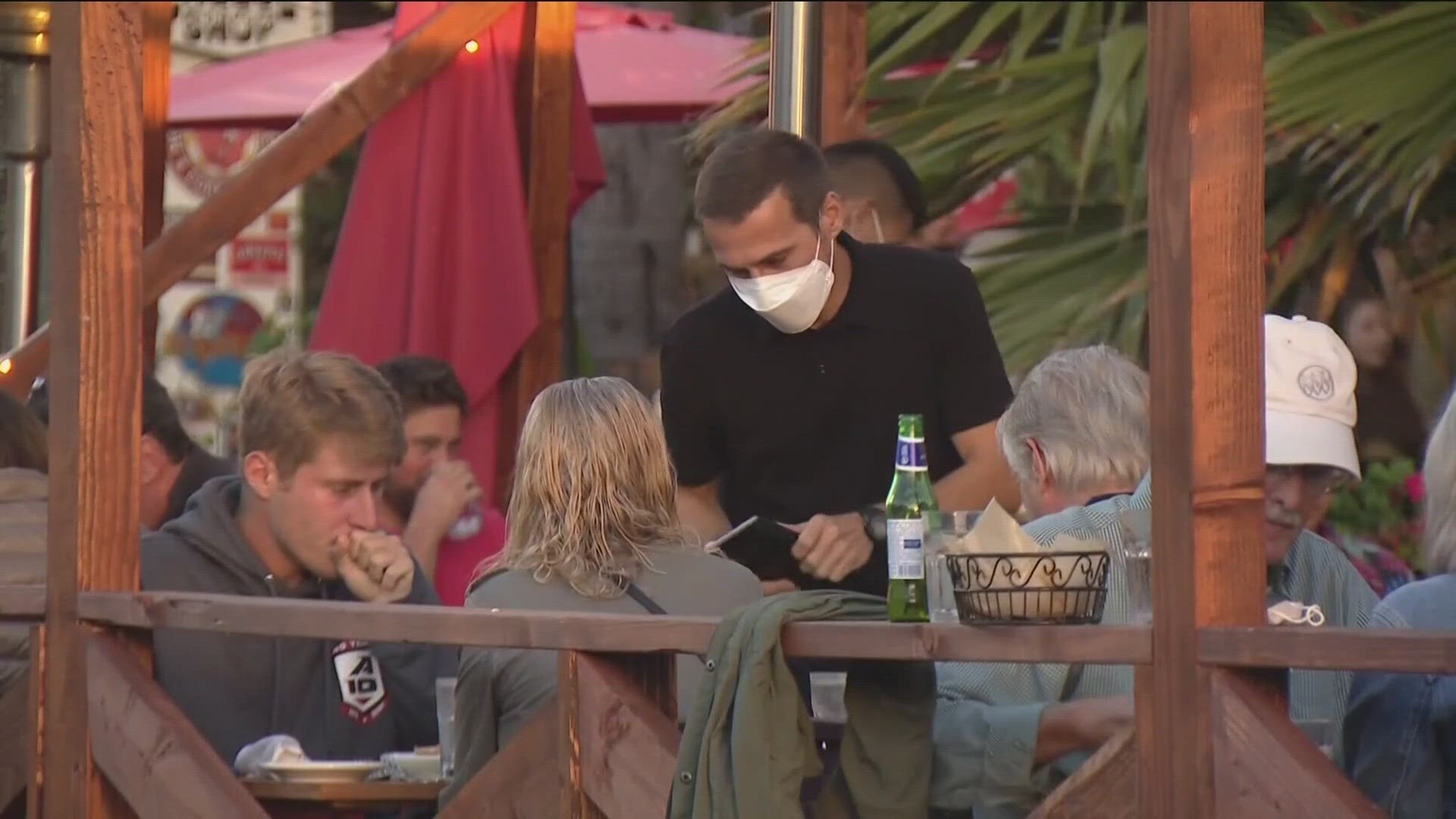SAN DIEGO COUNTY, Calif. — Editor’s note: This story shows updates about the coronavirus outbreak in San Diego and California from Aug. 11 - 13 (afternoon), 2020. Click here for real-time updates for Aug. 13, 2020 and on.
Key COVID-19 facts in San Diego and California:
- There are 33,659 confirmed cases in San Diego County and reported 615 deaths.
- There are 586,056 confirmed cases in California and 10,648 reported deaths.
- View San Diego County cases by zip code or city and find local testing sites.
- Click here for previous updates
Aug. 13
Aug. 12
Ocean Beach gatherings continue on smaller scale following increased police presence
Gatherings in Ocean Beach went as planned Wednesday night but on a smaller scale than was seen a week ago. The San Diego Police Department increased its presence in the area following complaints from residents. Just after 10 p.m. police walked around the drum circle being held and broke it up. Citations were issued for open containers and dogs without leashes but none were given for lack of social distancing or not wearing facial coverings.
State responds after more than a dozen California parents sue Governor Newsom to reopen schools
More than a dozen California parents are suing Governor Gavin Newsom over his school closure order. The lawsuit aims to reopen schools across the state, but the state is fighting back.
New study finds neck gaiters and bandanas least effective facial coverings
Public health experts and doctors agree everyone needs to wear a facial covering to help prevent the spread of coronavirus. However, a new study out of Duke University shows not all facial coverings are equally effective. Some very popular ones could actually do more harm than good.
San Diego County coronavirus case rate nears 1% of population, increase of cases slows
San Diego’s total case rate neared 1% of the county’s population Wednesday as the increase of cases slowed.
As of Wednesday, 33,393 people in the county have tested positive for the virus, more than double the number of cases in all of South Korea, according to data collected from John Hopkins University.
The highest case rate per population continues to be in the 92173 zip code, which includes San Ysidro, where more than 3.9% of residents have tested positive since the pandemic began. The South Bay has been hit particularly hard by coronavirus. Last week, the county announced a new partnership with South Bay Community Services to help reach out to the Latino community.
San Diego County to open new COVID-19 testing site at the border
A new COVID-19 testing site will begin operating Wednesday at the San Ysidro Port of Entry PedEast crossing.
The free site will operate from 6:30 to 10:30 a.m. Monday through Friday and will focus on testing essential workers and American citizens who live in Tijuana, as well as residents of the area.
San Diego County sees daily case count go down, but community outbreaks continue
San Diego County health officials reported 182 new COVID-19 infections Tuesday, the first time that fewer than 200 new cases have been reported since June 22.
However, eight coronavirus fatalities were reported Tuesday, raising the death toll to 602. Of the deaths, 96% had some underlying medical condition. The total case count for COVID-19 climbed to 33,157 Tuesday.
Aug. 11
University Heights gym shut down for violating health order
After receiving multiple warnings to close, but refusing to do so, Boulevard Fitness in University Heights received a visit Tuesday afternoon from San Diego police. Officers forced the business to shut down and cited its owner.
Hours later, however, the gym appeared to have reopened with people seen entering and exiting the gym around 9 p.m.
Wife sees hospitalized husband every day despite coronavirus restrictions thanks to nurses
As the coronavirus pandemic continues, restrictions on visitors in hospitals are still in place. That means patients have to rely on staff for emotional support now more than ever.
Allan Madrid has been at Kaiser Permanente for weeks suffering from a stroke following a traumatic brain injury.
While his wife can't go inside the hospital to see him, thanks to the nurses there, she's able to visit him every day.
Models used to predict how coronavirus will spread in San Diego County, statewide
California is using several forecast models to predict how coronavirus will spread on a state and county level.
Six projection models are averaged to look between two and four weeks out including one developed by the University of California – Los Angeles.
San Diego County tax collector offers relief for defaulted property tax bills
More than 28,000 defaulted bills were sent out to San Diego County taxpayers this week, but the county's treasurer announced Tuesday that his office is offering penalty relief.
"We know many of the late bills are due to COVID-19, and we want our taxpayers to know there could be relief," Treasurer-Tax Collector Dan McAllister said. "They may qualify to have their penalties waived if they file for a COVID-19 cancellation request. Our customers must provide documentation as evidence to show how the pandemic impacted their ability to pay their second installment by April 10."
View all News 8 coverage of coronavirus / COVID-19
News 8 has joined forces with The San Diego Foundation to raise immediate, emergency funds for our most vulnerable neighbors in need. Here is how you can help.
BACKGROUND:
On February 11, 2020 the World Health Organization announced an official name for the disease that is causing the 2019 novel coronavirus outbreak, first identified in Wuhan China. The new name of this disease is coronavirus disease 2019, abbreviated as COVID-19. In COVID-19, "CO" stands for "corona," "VI" for "virus," and "D" for disease. Formerly, this disease was referred to as “2019 novel coronavirus” or “2019-nCoV”.
There are many types of human coronaviruses including some that commonly cause mild upper-respiratory tract illnesses. COVID-19 is a new disease, caused by a novel (or new) coronavirus that has not previously been seen in humans.
Currently, there is no vaccine, however, the CDC suggests the following precautions, as with any other respiratory illness:
Know how it spreads:
- The best way to prevent illness is to avoid being exposed to this virus.
- The virus is thought to spread mainly from person-to-person.
- Between people who are in close contact with one another (within about 6 feet).
- Through respiratory droplets produced when an infected person coughs, sneezes or talks.
- These droplets can land in the mouths or noses of people who are nearby or possibly be inhaled into the lungs.
- Some recent studies have suggested that COVID-19 may be spread by people who are not showing symptoms.
Protect yourself and others
Wash your hands often
- Wash your hands often with soap and water for at least 20 seconds especially after you have been in a public place, or after blowing your nose, coughing, or sneezing.
- It’s especially important to wash:
- Before eating or preparing food
- Before touching your face
- After using the restroom
- After leaving a public place
- After blowing your nose, coughing, or sneezing
- After handling your cloth face covering
- After changing a diaper
- After caring for someone sick
- After touching animals or pets
- If soap and water are not readily available, use a hand sanitizer that contains at least 60% alcohol. Cover all surfaces of your hands and rub them together until they feel dry.
- Avoid touching your eyes, nose, and mouth with unwashed hands.
Avoid close contact
- Inside your home: Avoid close contact with people who are sick.
- If possible, maintain 6 feet between the person who is sick and other household members.
- Outside your home: Put 6 feet of distance between yourself and people who don’t live in your household.
- Remember that some people without symptoms may be able to spread virus.
- Stay at least 6 feet (about 2 arms’ length) from other people.
- Keeping distance from others is especially important for people who are at higher risk of getting very sick.
Cover your mouth and nose with a cloth face cover when around others
- You could spread COVID-19 to others even if you do not feel sick.
- The cloth face cover is meant to protect other people in case you are infected.
- Everyone should wear a cloth face cover in public settings and when around people who don’t live in your household, especially when other social distancingmeasures are difficult to maintain.
- Cloth face coverings should not be placed on young children under age 2, anyone who has trouble breathing, or is unconscious, incapacitated or otherwise unable to remove the mask without assistance.
- Do NOT use a facemask meant for a healthcare worker. Currently, surgical masks and N95 respirators are critical supplies that should be reserved for healthcare workers and other first responders.
- Continue to keep about 6 feet between yourself and others. The cloth face cover is not a substitute for social distancing.
Cover coughs and sneezes
- Always cover your mouth and nose with a tissue when you cough or sneeze or use the inside of your elbow and do not spit.
- Throw used tissues in the trash.
- Immediately wash your hands with soap and water for at least 20 seconds. If soap and water are not readily available, clean your hands with a hand sanitizer that contains at least 60% alcohol.
Clean and disinfect
- Clean AND disinfect frequently touched surfaces daily. This includes tables, doorknobs, light switches, countertops, handles, desks, phones, keyboards, toilets, faucets, and sinks.
- If surfaces are dirty, clean them. Use detergent or soap and water prior to disinfection.
- Then, use a household disinfectant. Most common EPA-registered household disinfectantsexternal icon will work.
Monitor your health daily
- Be alert for symptoms. Watch for fever, cough, shortness of breath, or other symptoms of COVID-19.
- Especially important if you are running essential errands, going into the office or workplace, and in settings where it may be difficult to keep a physical distance of 6 feet.
- Take your temperatureif symptoms develop.
- Don’t take your temperature within 30 minutes of exercising or after taking medications that could lower your temperature, like acetaminophen.
- Follow CDC guidance if symptoms develop.
The California Department of Public Health has issued guidance on the use of cloth face coverings to protect against the spread of the novel coronavirus COVID-19.
As of April 4, 2020, all employees in San Diego County who may have contact with the public in any grocery store, pharmacy/drug store, restaurant or food establishments, convenience store or gas station are required to wear a cloth face covering while at work as an additional measure to help “flatten the curve” in the San Diego region.
As of May 1, San Diego County requires everyone in the county to wear face coverings in many public settings. The coverings help prevent the spread of COVID-19 and are part of our path to reopening San Diego. See full health order here.
While officials say these face coverings are not a substitute for practices like social distancing and handwashing, there is evidence to suggest that the use of cloth face coverings by the public during a pandemic could help reduce disease transmission. Officials do not recommend the public use N-95 or surgical masks which are needed by health care workers and first responders.



